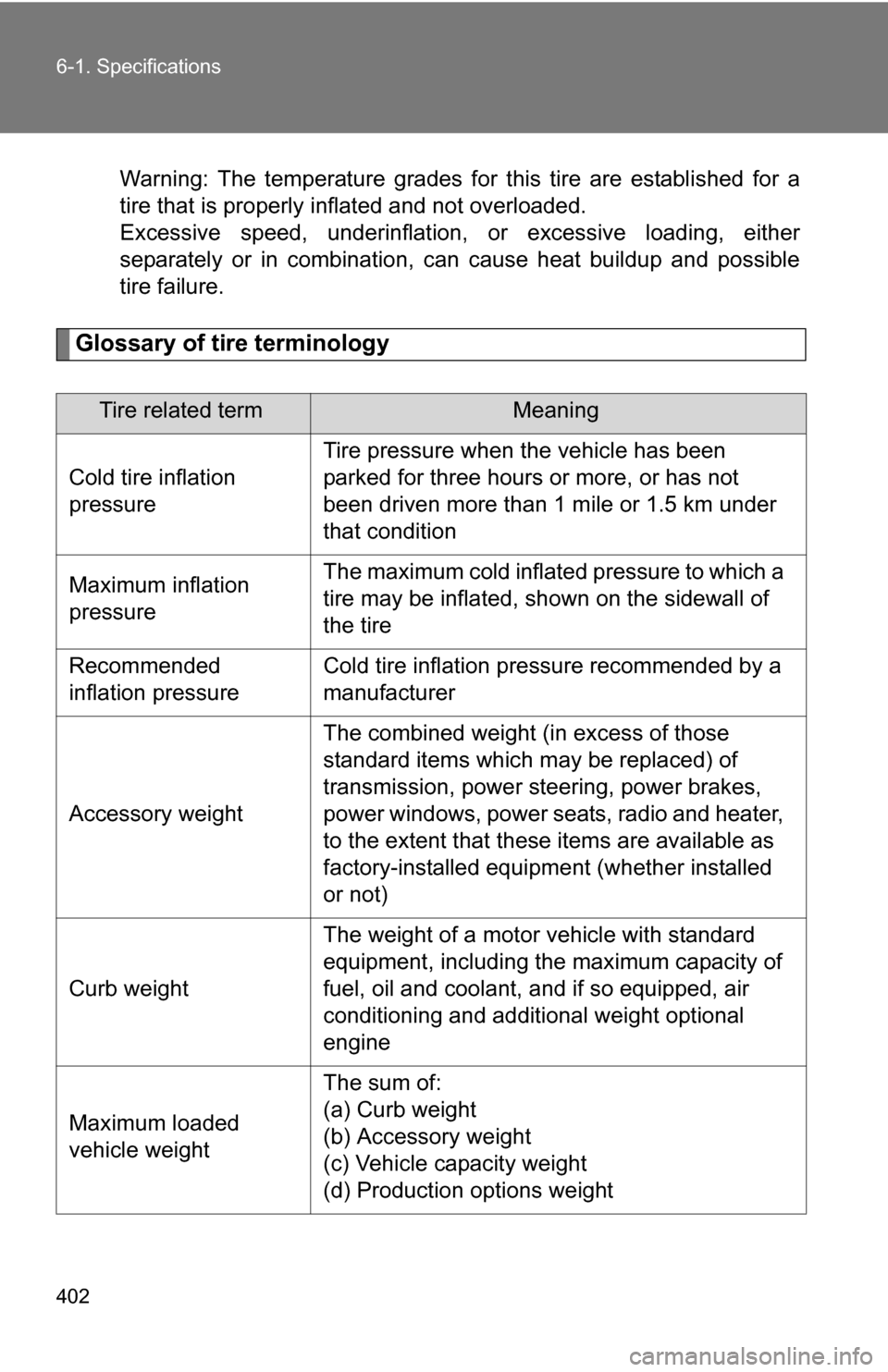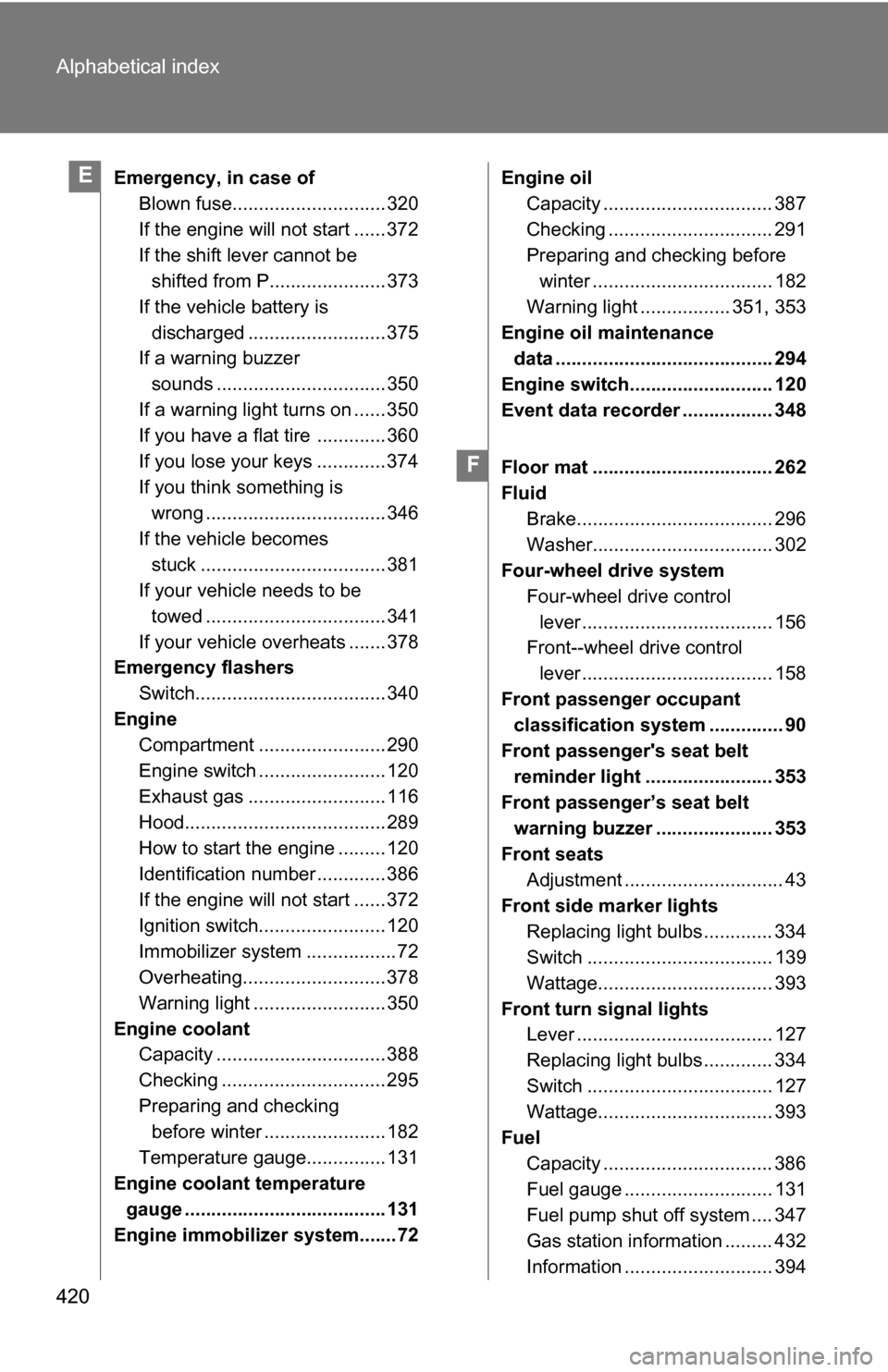Page 296 of 432
296 4-3. Do-it-yourself maintenance
Radiator and condenserCheck the radiator and condenser and clear any foreign objects.
If either of the above parts are ex tremely dirty or you are not sure of
their condition, have your vehicl e checked by your Toyota dealer.
Brake fluid
■ Checking fluid level
The brake fluid level should be
between the MAX and MIN lines
on the reservoir.
NOTICE
■When adding engine coolant
Coolant is neither plain water nor stra ight antifreeze. The correct mixture of
water and antifreeze must be used to provide proper lubrication, corrosion
protection and cooling. Be sure to read the antifreeze or coolant label.
■ If you spill coolant
Be sure to wash it off with water to prevent damage to parts or paint.
CAUTION
■When the engine is hot
Do not touch the radiator or condenser as they may be hot and may cause
burns.
Page 346 of 432
346
5-1. Essential information
If you think something is wrong
If you notice any of the following symptoms, your vehicle probably
needs adjustment or repair. Contact your Toyota dealer as soon as
possible.
■ Visible symptoms
●Fluid leaks under the vehicle
(Water dripping from the air cond itioning after use is normal.)
● Flat-looking tires or uneven tire wear
● Engine coolant temperature g auge needle continually points
higher than normal
● Voltmeter continually points higher or lower than normal.
■ Audible symptoms
●Changes in exhaust sound
● Excessive tire squeal when cornering
● Strange noises related to the suspension system
● Pinging or other noises related to the engine
■ Operational symptoms
●Engine missing, stumbling or running rough
● Appreciable loss of power
● Vehicle pulls heavily to one side when braking
● Vehicle pulls heavily to one side when driving on a level road
● Loss of brake effectiveness, s pongy feeling, pedal almost
touches the floor
Page 379 of 432
5
When trouble arises
379
5-2. Steps to take in an emergency
The engine has cooled down sufficiently.
The engine coolant temperature gauge indicates C.
Check the engine coolant level.
Look for obvious coolant leaks
from the radiator, hoses and
under the vehicle.
Note that water draining from the air conditioning is normal if it has
been used.
Add engine coolant if required.
Water can be used in an emer-
gency if engine coolant is
unavailable. ( P. 388)
Have the vehicle checked at your nearest Toyota dealer as soon as
possible.
Page 380 of 432

380 5-2. Steps to take in an emergency
■Overheating
If you observe the following, your vehicle may be overheating.
●The engine coolant temperature gauge enters the red zone or a loss of
power is experienced.
● Steam is coming from under the hood.
CAUTION
■To prevent an accident or injury when inspecting under the hood of
your vehicle
● If steam is seen coming from under the hood, do not open the hood until
the steam has subsided. The engine compartment may be very hot, caus-
ing serious injury such as burns.
● Keep hands and clothing away from the fan and other belts while the
engine is running.
● Do not loosen the radiator cap while the engine and radiator are hot.
Serious injury, such as burns, may result from hot coolant and steam
released under pressure.
NOTICE
■When adding engine coolant
Wait until the engine has cooled down before adding engine coolant.
When adding coolant, do so slowly. Adding cool coolant to a hot engine too
quickly can cause damage to the engine.
Page 402 of 432

402 6-1. Specifications
Warning: The temperature grades for this tire are established for a
tire that is properly inflated and not overloaded.
Excessive speed, underinflation, or excessive loading, either
separately or in combination, can cause heat buildup and possible
tire failure.
Glossary of tire terminology
Tire related termMeaning
Cold tire inflation
pressure
Tire pressure when the vehicle has been
parked for three hours or more, or has not
been driven more than 1 mile or 1.5 km under
that condition
Maximum inflation
pressureThe maximum cold inflated pressure to which a
tire may be inflated, s hown on the sidewall of
the tire
Recommended
inflation pressureCold tire inflation pressure recommended by a
manufacturer
Accessory weight
The combined weight (in excess of those
standard items which may be replaced) of
transmission, power steering, power brakes,
power windows, power seats, radio and heater,
to the extent that these items are available as
factory-installed equipment (whether installed
or not)
Curb weight
The weight of a motor vehicle with standard
equipment, including the maximum capacity of
fuel, oil and coolant, and if so equipped, air
conditioning and additional weight optional
engine
Maximum loaded
vehicle weight
The sum of:
(a) Curb weight
(b) Accessory weight
(c) Vehicle capacity weight
(d) Production options weight
Page 420 of 432

420 Alphabetical index
Emergency, in case ofBlown fuse............................. 320
If the engine will not start ...... 372
If the shift lever cannot be shifted from P...................... 373
If the vehicle battery is discharged .......................... 375
If a warning buzzer
sounds ................................ 350
If a warning light turns on ...... 350
If you have a flat tire ............. 360
If you lose your keys ............. 374
If you think something is wrong .................................. 346
If the vehicle becomes stuck ................................... 381
If your vehicle needs to be
towed .................................. 341
If your vehicle overheats ....... 378
Emergency flashers
Switch.................................... 340
Engine Compartment ........................ 290
Engine switch ........................ 120
Exhaust gas .......................... 116
Hood...................................... 289
How to start the engine ......... 120
Identification number ............. 386
If the engine will not start ...... 372
Ignition switch........................ 120
Immobilizer system .................72
Overheating........................... 378
Warning light ......................... 350
Engine coolant Capacity ................................ 388
Checking ............................... 295
Preparing and checking before winter ....................... 182
Temperature gauge............... 131
Engine coolan t temperature
gauge ...................................... 131
Engine immobilizer system.......72 Engine oil
Capacity ................................ 387
Checking ............................... 291
Preparing and checking before winter .................................. 182
Warning light ................. 351, 353
Engine oil maintenance data ......................................... 294
Engine switch........................... 120
Event data recorder ................. 348
Floor mat .................................. 262
Fluid Brake..................................... 296
Washer.................................. 302
Four-wheel drive system
Four-wheel drive control lever .................................... 156
Front--wheel drive control
lever .................................... 158
Front passenger occupant classification system .............. 90
Front passenger's seat belt reminder light ........................ 353
Front passenger’s seat belt
warning buzzer ...................... 353
Front seats Adjustment .............................. 43
Front side marker lights Replacing light bulbs ............. 334
Switch ................................... 139
Wattage................................. 393
Front turn signal lights Lever ..................................... 127
Replacing light bulbs ............. 334
Switch ................................... 127
Wattage................................. 393
Fuel Capacity ................................ 386
Fuel gauge ............................ 131
Fuel pump shut off system .... 347
Gas station information ......... 432
Information ............................ 394E
F
Page 426 of 432
426
What to do if...
What to do if...
A tire puncturesP. 360If you have a flat tire
The engine does not start
P. 372If the engine will not start
P. 7 2Engine immobilizer system
P. 375If the battery is discharged
The shift lever cannot be
moved outP. 373If the shift lever cannot be shifted
from P
The engine coolant temperature
gauge enters the red zone
Steam can be seen coming
from under the hood
P. 378If your vehicle overheats
The key is lostP. 374If you lose your keys
The battery runs outP. 375If the battery is discharged
The doors cannot be locked
P. 3 3Side doors
P. 3 6Access doors
P. 3 8Back door
The vehicle is stuck in
mud or sandP. 381If the vehicle becomes stuck
The warning light or indicator
light comes onP. 350If a warning light turns on